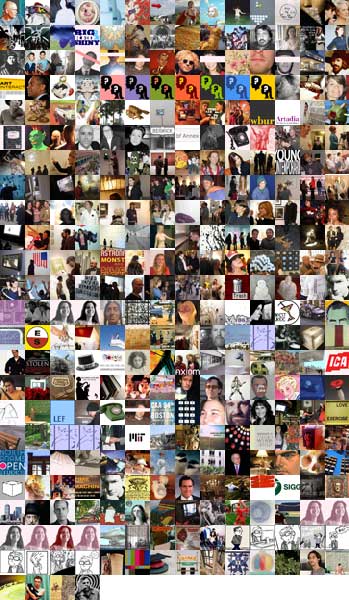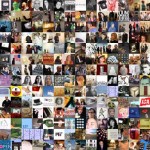In the autumn of 2002, I was starting my second year of teaching at the Museum School in Boston. Among the graduate students, and some of the faculty, there was an intense energy that was being fueled by Boston’s thriving alternative scene. Yet that scene was also showing signs of strain, as the number of alt-venues and the availability of cheap space both declined. It seemed important to bring more attention to the art happening in the city, beyond the decent but limited scopes of The Boston Globe, Boston Herald, Boston Phoenix and Weekly Dig.
One evening on my way to teach a web design class, I got caught up in a conversation with an energetic graduate student named Sean Horton, who wanted me to consider an idea for bringing arts coverage in Boston to the web. The idea was very strong, and since blog culture was still in its infancy and Boston was a fairly small scene, it seemed feasible to pool the efforts of motivated artists and create something worthwhile.
One of the questions I often get is “What does Big RED & Shiny mean?” The name is an art school joke, told in various forms at different institutions, but the Museum School version goes: “If you can’t make it good, make it big. If it doesn’t look good big, make it red. If you want it to sell, make it shiny.” Among the students and faculty, saying that someone’s art is “Big RED & Shiny” is saying that it is bad art, cheap, generic, and trendy. Jennifer Schmidt revived it as a title option for the site, and it seemed funny to start off calling ourselves cheap and bad before going out and critiquing others.
As fall turned to winter, then spring, I poked around on the project, using it as an excuse to learn Perl, and eventually created a basic working model for an art journal. By the time it was ready to go, Horton was bogged down with his thesis exhibition and backed out of the project. After some searching, I found Michael Brodeur (currently at Boston’s Weekly Dig) as an editor. He helped with the site design, and is the reason all the pages are pink. However, his availability soon waned, and again the project sat dormant.
The longer the project sat, the more frustrated I grew. I knew that it would take the efforts of more than myself, yet every editor that came along faded before we could actually launch the site. Eventually I decided to cancel the site, let Big RED & Shiny become another failed attempt at something meaningful, and save myself the money. I was on the verge of clicking the cancel button when the phone rang: it was Sean Horton.
Having hung his thesis, he now had more free time and was wondering what happened to the art journal project. Over the course of an hour-long phone conversation it became clear that the project should go forward, and that Sean would make things happen quickly. I finalized some code while he recruited writers, and within a few weeks the project I thought dead was live and drawing a modest audience.
Sean worked very hard for the first seven issues, recruiting writers and defining the voice and the scope of our little pink website. He worked tirelessly to ensure that Boston was represented accurately, covering shows at major museums, commercial galleries, in basements, attics, and anywhere that the energy of the city found voice. However, just prior to our eighth issue, a curatorial position in Burligton (and later New York) caused him to resign.
If Sean Horton laid the groundwork for Big RED & Shiny, it was Matthew Gamber who truly realized it’s potential. Stepping in as editor for our ninth issue, he has led the project ever since. Under his leadership we have seen a drastic growth in audience, in contributors, in donors, and in coverage. What was once a small pink website covering Boston has become a large pink website covering New England, with regular reports from many cities beyond.
Alongside Gamber and myself, Big RED has seen a series of executive editors who work to recruit writers, coach projects and ideas to completion, and generally ensure the quality of the site. Christophe Perez helped out for a brief period around issues 9 thru 12. Later, when Gamber moved to Savannah to take a teaching position, regular contributors Micah Malone and Rachel Gepner stepped in to handle executive duties while Gamber focused on overall thematic development. Micah and Rachel each brought tremendous talents to the project, and the marked change in Big RED & Shiny since issue twenty-six is due to their leadership and ideas. Recently, Rachel has decided to take less of a role in editing, while continuing to contribute as a writer, and founding contributor Christian Holland has stepped up to an executive position.
Overall, Big RED & Shiny is an evolving and changing project, and a home to many diverse voices. We have rarely turned anyone away, and hope to present the best picture of the Boston art scene that we can. This does not mean that we are always nice, or say only glowing things, as that does not represent the art of a city well. We hope, instead, to speak honestly about what is happening in our region, and make the arts of New England a topic of discussion around the world. We are never the same magazine twice, always looking to surprise and delight with each new issue.
Big RED & Shiny is my passion. When I marvel at the depth of our archive, and how densely packed it is with meaningful ideas and rich sentiment, I am proud of our little pink website.
- Big RED & Shiny published 326 pieces in the past year.
----





